Four new Marsden projects for GNS Science
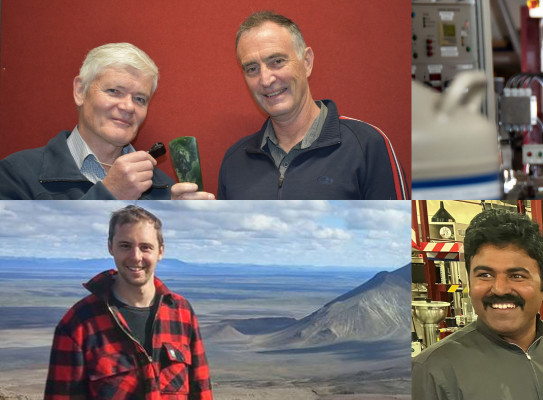
GNS Science, Te Pū Ao has been awarded funding for four projects from Te Pūtea Rangahau a Marsden (the Marsden Fund), for research into magma, the special properties of pounamu, fabricating energy materials and advances in solar power.
The four projects were split between the Standard and Fast-Start funding streams.
GNS chief scientists Dr Gary Wilson says the GNS projects funded by Marsden this year demonstrate our commitment to innovation in the research we undertake.
“Our research is grounded in key challenges and questions facing the people of Aotearoa New Zealand. These projects single out the particular challenges we face as a nation in developing future energy pathways, understanding and living with our Natural Hazards and Risks and recognising the importance of Māori partnerships in our research. We are also excited to see the mix of early career and experienced scientists receiving these prestigious research opportunities."
All of our projects have research partners across New Zealand and Internationally and I look forward to the joint benefits and impacts we will generate with them
Overall, the fund allocated $77.391 million to 113 research projects led by researchers in Aotearoa New Zealand. The fund is managed by Royal Society Te Apārangi on behalf of the New Zealand Government with funding from the Ministry of Business, Innovation and Employment.
Why is pounamu so tough?
The first Marsden standard project focuses on weaving materials science and mātauranga Māori to jointly paint a picture about the special physical properties and uses of pounamu - Aotearoa’s nephrite jade.
Working with Ngāi Tahu, pounamu artisans and colleagues from the University of Otago, the project is the next step for the legacy of the Beck International Jade Research Collection, which was vested with GNS Science by Russell Beck and Te Rūnanga o Ngāi Tahu in 2017.
Titled, Why is pounamu tough? Using materials science and mātauranga Māori to explain the special physical properties and uses of nephrite jade, GNS scientists Dr Simon Cox and Dr Nick Mortimer will lead the materials science aspects of the colloboration.
As a Ngāi Tahu whānau member involved in supporting GNS for many years, Te Rūnanga o Ngāti Waewae Chair Francois Tumahai touches on the significance of sharing insights into pounamu. “The central outcome of this kaupapa is the two-way transfer of knowledge that will occur between the scientists and those Ngāi Tahu whānau members involved."
Scientists drill down on pounamu properties | Te Ao Tapatahi
Why is pounamu so tough? That’s a question for the kaitiaki of this taonga, Ngāi Tahu, who will be working alongside a team from GNS Science

Ultimately, it presents a fully funded opportunity for our people to upskill and broaden their knowledge base about something that is of huge significance to our iwi.
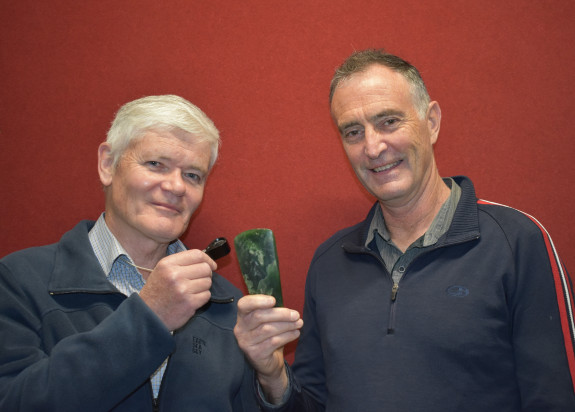
Dr Cox says in Aotearoa, pounamu is a tāonga and the subject of much mātauranga and the project has been built on over nearly two decades of pounamu research together with Ngāi Tahu. “Long-term aspirations for research on pounamu were discussed between Ngāi Tahu elders and GNS Science at the Beck International Jade Research Collection launch in 2017, where ideas for this project germinated.
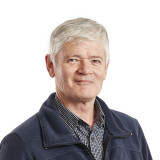
It is renowned for its extreme toughness compared to other rocks, which is why it was historically revered so highly as a tool that holds a sharp edge. It also makes it very suitable for artisanal work such as carving and shaping.
"We all have a lot of theories to explain its special properties," Dr Cox says. "But this gives us the platform to explore it further using state-of-the-art materials science and iwi cultural knowledge to form a larger picture of pounamu use over time. Knowledge transfer will be two-way: bringing together scientists who are unfamiliar with the carving properties or history of various samples and pounamu artisans who have yet to include physical science data in their work. Ngāi Tahu’s kaupapa and tikanga around their tino tāonga, as well as mātauranga on pounamu, are integral to research success and two-way knowledge transfer.”
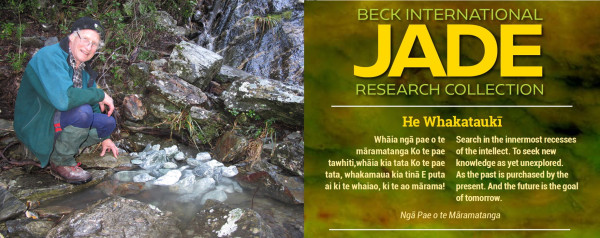
It is hoped that it will be useful in informing the selection and cutting process of high-quality pounamu for carving and illuminate future development of super-tough synthetic materials.
“With its cultural, geological, archaeological and materials science significance, this project could rewrite the jade textbooks of the world and lead to better management of this precious resource,” Dr Cox says.
As results come in, public talks, hui and communication of results are important to the project group. Dr Cox and Dr Mortimer have recently given three interactive talks at Otago Museum as part of The Kura Pounamu: Our Treasured Stone exhibition called, Understanding Stone: Pounamu’s Geology.
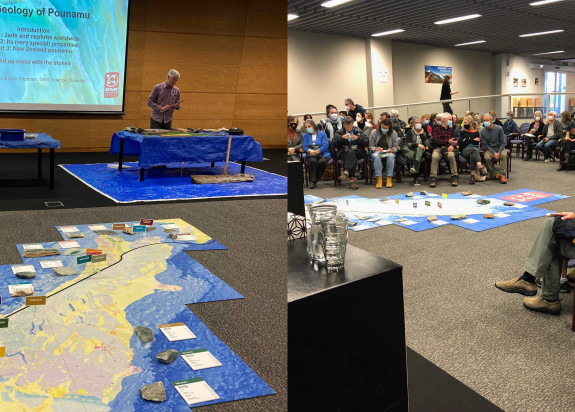
Nephrite jade and pounamu are unusual rocks in that they have metal-like toughness, in other words they are very resistant to fracture. Why this should be is a scientific mystery
Dr Mortimer says that he and the team feel very privileged to be studying a taonga such as pounamu. "The mineralogical explanation of pounamu’s physical toughness remains elusive. The minerals in pounamu are all fairly soft yet the rock is tough. This makes it excellent for carving, and for creating objects which keep a sharp edge. We think the longstanding explanation - of twisted mineral fibres - is wrong. We will be testing other theories - including ultra-fine grain size and stored strain.”
Transforming solar power generation
GNS principal scientist Dr John Kennedy will explore whether ‘wonder crystals’ known as Perovskites could help transform solar power generation by overcoming some of the barriers to their widespread use.
Dr Kennedy has extensive knowledge of the development of functional materials for energy technologies to explore the idea with his collaborators from across the globe.

The potential of perovskites for creating higher efficiency solar energy devices is listed as a science event to watch by Nature
“Halide perovskite materials offer excellent light absorption and charge-carrier mobilities, resulting in high device efficiencies with opportunities to realise a low-cost, industry-scalable technology," Dr Kennedy says. "They align closely with silicon materials which make them a strong candidate for replacing silicon materials used for solar energy. So, there are a lot of scientists around the world are trying to overcome the barriers related to stability, environmental compatibility, and reproducibility with using them for solar energy.”
The project aim is to discover the links between strain and material properties and develop a comprehensive strain-modulation strategy for halide perovskite to unravel the structure-material property relationships, which could enable the elimination of the barriers and empower widespread application of perovskite material.
To achieve the desired objectives our approach requires a multidisciplinary investigation spanning chemical synthesis of halide perovskite, ion beam science combined with combinational physics , supplemented by optical and electrical characterisation. For this reason, Dr Kennedy will be working with Professor Jonathan Halpert Hong Kong University of Science and Technology and Dr Jörg Schuster Fraunhofer of the Fraunhofer Institute for Electronic Nano Systems in Germany.
Simulating our most explosive magmas
Early career scientist Dr Shane Rooyakkers has received a Fast-Start grant for the project, Explosion or lava? Understanding controls on the eruption style of rhyolite magma.
Dr Rooyakkers says rhyolite magmas generate the most explosive eruptions on Earth, but can also erupt non-explosively to form less hazardous lava flows and domes. The transitions between explosive and non-explosive activity commonly occur within individual eruptions, but volcanologists do not yet understand what controls this contrasting behaviour. The Taupō Volcanic Zone in New Zealand’s North Island is host to the two most frequently active and productive rhyolite volcanoes on Earth, providing Rooyakkers and his team with an ideal testbed to explore new ideas around the eruptive behaviour of these temperamental magmas.
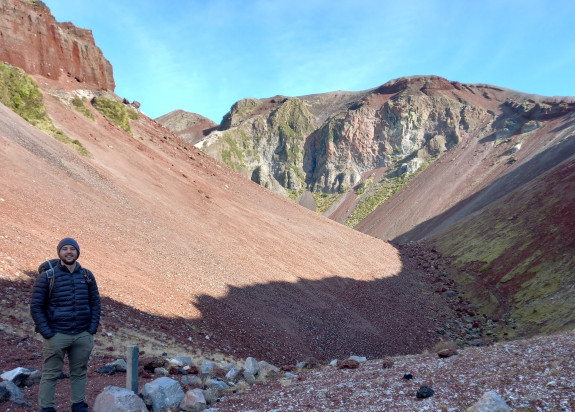
By studying these volcanic products, we aim to advance understanding of processes that occur inside volcanic conduits as magma ascends to the surface and find out what tips the balance between explosive and non-explosive activity.
The research will see the first ever decompression experiments on New Zealand magmas, which Dr Rooyakkers will perform in Austin, Texas. These high-temperature experiments allow magma ascent to be simulated in the laboratory under controlled conditions, which can then be linked to nature by comparing experimental and natural products.
“By analysing these features and performing decompression experiments that simulate magma ascent, we will unravel the dynamic interplay between magma ascent, gas loss, bubble and crystal growth, magma viscosity and sintering (sticking-together) of explosively-fragmented magma particles in the conduit, and their effects on eruption styles. This will be a critical step in advancing our understanding of evolving hazards during rhyolite eruptions.”
Dr Rooyakkers says a series of hui will be help to explore alignment of the research with iwi interests and learn how mātauranga Māori can help develop shared understanding of the landscapes and volcanic history the volcanoes.
The research will involve early career, summer research interns and experienced scientists from University of Texas at Austin, Durham University, University at Buffalo, and Victoria University of Wellington.
Exploring New Pathways for Fabricating Energy Materials – Continuing Lord Rutherford’s and Sir Marsden’s legacy
Led by early career ion beam scientist Dr Prasanth Gupta, this Fast-Start research will explore new pathways based on ion beam science for manufacturing novel materials for energy conversion and storage.

Ion implantation is an important material technology that has made computers and mobile phones possible. Every smart gadget has a semiconductor chip fabricated from an ion implanter. The science behind this technology and this Marsden research stems directly from Lord Rutherford’s and Sir Marsden’s famous ‘Gold Foil Experiment’.
In the gold foil experiment, alpha particles – positively charged ions, were bombarded on a thin gold foil. By studying the interaction of these energetic ions with solid matter, the atomic nucleus was discovered. This Marsden research studies the same interaction but in a different context.
“When a fast-moving ion impacts a solid surface, it releases a tremendous amount of energy. For few picoseconds, the local temperature of the material raises by several thousand Kelvin – known as a thermal spike,”says Dr Gupta.
We generally look at this as an ‘unwelcome’ side-effect but what if we could utilise this energy to produce an important class of energy materials?
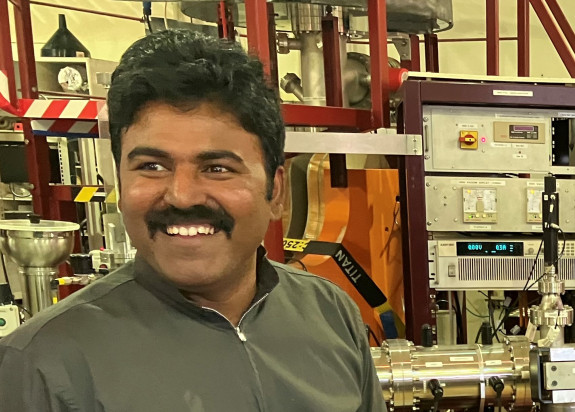
Dr Gupta and colleagues aim to establish a fundamental framework that explains the chemistry of ion-solid interactions. Leveraging this knowledge, they aim to develop new synthetic routes to form ultra-fine transition metal carbide nanoparticles, which are extremely challenging to synthesise using conventional approaches. These materials have promising applications in batteries, supercapacitors, fuel cells and electrolysers, if they are made of the right size and phase.
He will be working with University of Auckland Associate Professor Geoffrey Waterhouse and GNS’ Dr John Kennedy. Dr Kennedy says that Prasanth aspires to become an expert in developing functional nanomaterials for sustainable energy technologies.
“Dr Gupta is a highly innovative science leader who has expertise in fabrication of thin films and energy materials by ion beam engineering. He has the skills and the necessary resources and expertise to tackle this novel and ambitious project. I look forward to working with him and seeing him grow through this research.”